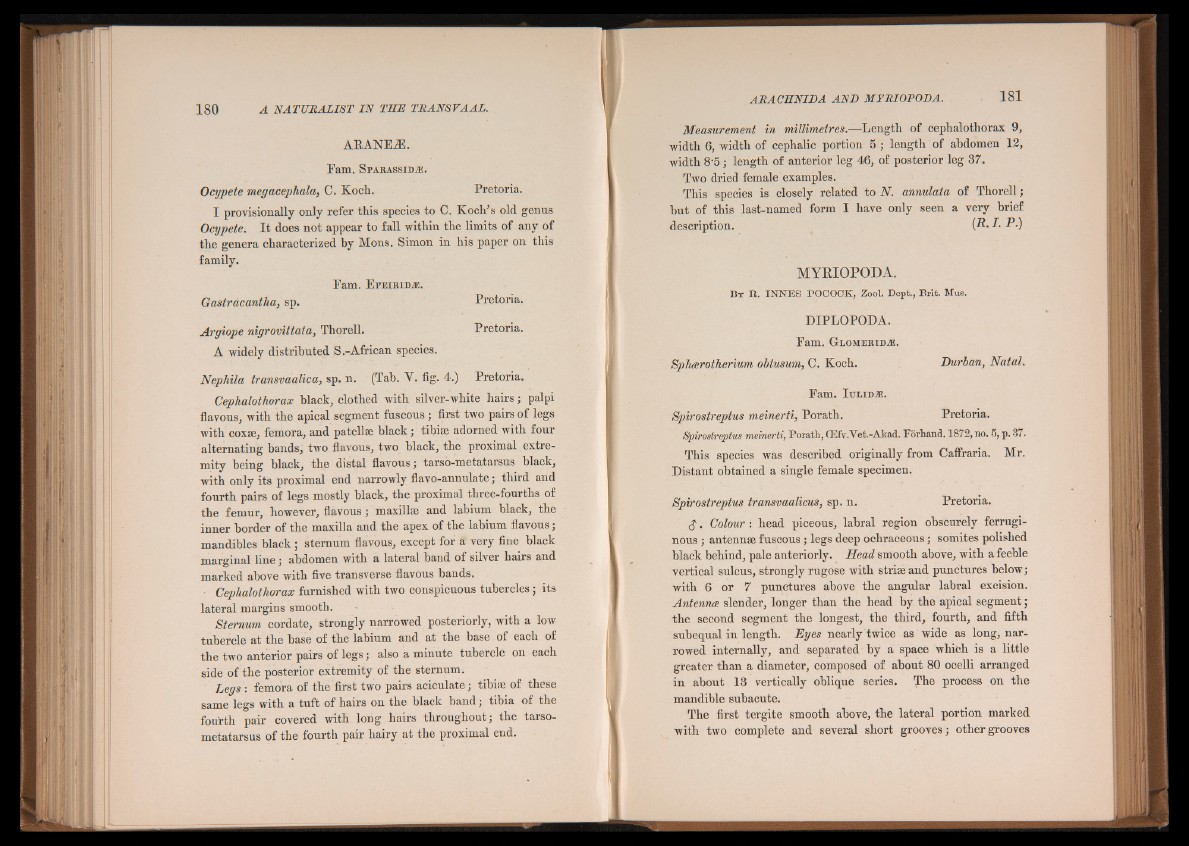
ARANEÆ.
Fam. S p a r a s s id æ .
Ocypete megacephala, C. Koch. Pretoria.
I provisionally only refer this species to C. Koch’s old genus
Ocypete. It does not appear to fall within the limits of any of
the genera characterized by Mons. Simon in his paper on this
family.
Fam. E f e i k i d æ .
Gastracantha, sp. Pretoria.
Argiope nigrovittata, Thorell. Pretoria.
A widely distributed S.-African species.
Nephila transvaalica, sp. n. (Tab. V. fig. 4.) Pretoria.
Céphalothorax black, clothed with silver-white hairs ; palpi
flavous, with the apical segment fuscous ; first two pairs of legs
with coxae, femora, and patellae black ; tibiae adorned with four
alternating bands, two flavous, two black, the proximal extremity
being black, the distal flavous \ tarso-metatarsus black,
with only its proximal end narrowly flavo-annulate ; third and
fourth pairs of legs mostly black, the proximal three-fourths of
the femur, however, flavous ; maxillae and labium black, the
inner border of the maxilla and the apex of the labium flavous ;
mandibles black ; sternum flavous, except for a very fine black
marginal line ; abdomen with a lateral hand of silver hairs and
marked above with five transverse flavous bands.
Céphalothorax furnished with two conspicuous tubercles ; its
lateral margins smooth.
Sternum cordate, strongly narrowed posteriorly, with a low
tubercle at the base of the labium and at the base of each of
the two anterior pairs of legs ; also a minute tubercle on each
side of the posterior extremity of the sternum.
Legs : fem o r a of the first two pairs aciculate ; tibiæ of these
same legs with a tuft of hairs on the black band ; tibia of the
fourth pair covered with long hairs throughout; the tarso-
metatarsus of the fourth pair hairy at the proximal end.
Measurement in millimetres.— Length of cephalothorax 9,
width 6, width of cephalic portion 5 ; length of abdomen 12,
width 8-5 ; length of anterior leg 46, of posterior leg 37.
Two dried female examples.
This species is closely related to N. annulata of Thorell;
but of this last-named form I have only seen a very brief
description. (&• & P-)
MYRIOPODA.
By R. INNES POOOCK, Zool. Dept., Brit. Mus.
DIPLOPODA.
Fam. G lom e r id .® .
Spharotherium obtusum, C. Koch. Durban, Natal.
Fam. I u l id jE .
Spirostreptus meinerti, Porath. Pretoria.
Spirostreptus meinerti, Porath, (Efv.Vet.-Akad. Forhand. 1872, no. 5, p. 37.
This species was described originally from Caffraria. Mr.
Distant obtained a single female specimen.
Spirostreptus transvaalicus, sp. n. Pretoria.
. Colour : head piceous, labral region obscurely ferruginous
; antennae fuscous; legs deep ochraceous; somites polished
black behind, pale anteriorly. Head smooth above, with a feeble
vertical sulcus, strongly rugose with striae and punctures below;
with 6 or 7 punctures above the angular labral excision.
Antenna slender, longer than the head by the apical segment;
the second segment the longest, the third, fourth, and fifth
subequal in length. Eyes nearly twice as wide as long, narrowed
internally, and separated by a space which is a little
greater than a diameter, composed of about 80 ocelli arranged
in about 13 vertically oblique series. The process on the
mandible subacute.
The first tergite smooth above, the lateral portion marked
with two complete and several short grooves; other grooves